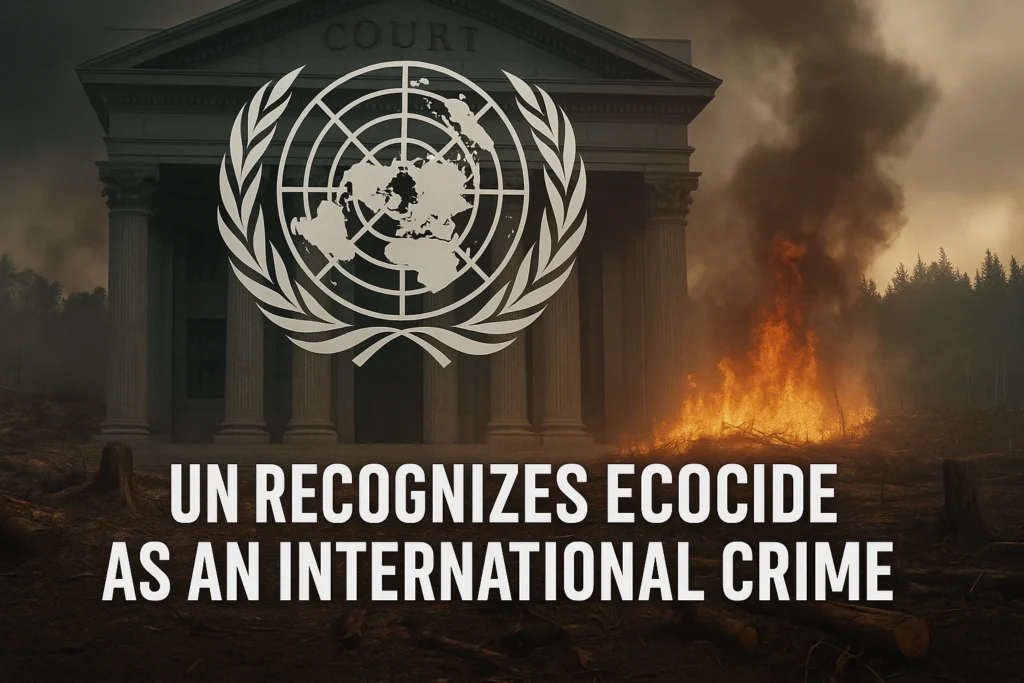A Legal Earthquake: The UN’s Historic Decision
The United Nations General Assembly made history by adopting a resolution that fundamentally changes how humanity relates to the natural world. By an overwhelming majority, member states voted to recognize ecocide—the widespread, long-term destruction of ecosystems—as the fifth international crime under the Rome Statute of the International Criminal Court (ICC). This places environmental destruction on the same legal footing as genocide, war crimes, crimes against humanity, and crimes of aggression.
The implications are profound. For the first time in history:
- CEOs whose decisions lead to environmental catastrophes could face international criminal prosecution
- Government leaders approving ecologically disastrous projects may be personally liable
- Military commanders using environmental destruction as a weapon could be tried as war criminals
- Financial backers of destructive industries may be held accountable as accomplices
The Birth of a Concept: From Vietnam to The Hague
Agent Orange and the Origins of Ecocide
The term “ecocide” first entered global consciousness during the Vietnam War. Between 1961-1971, the U.S. military conducted Operation Ranch Hand, spraying 20 million gallons of herbicides—including the infamous Agent Orange—over Vietnamese forests and farmland. The results were catastrophic:
- 5 million acres of forest destroyed
- 500,000 birth defects attributed to dioxin exposure
- Centuries-old ecosystems wiped out in months
American biologist Arthur Galston, who had helped develop the herbicides, became horrified by their use. In 1970, he coined the term “ecocide” to describe this deliberate environmental annihilation, asking: “If you destroy the environment on which a people depends for their food and shelter, are you not committing genocide by indirect means?”
The Legal Crusade of Polly Higgins
For decades, ecocide remained a moral concept without legal teeth—until Scottish barrister Polly Higgins took up the cause. In 2010, Higgins made a bold proposal to the UN Law Commission: amend the Rome Statute to include ecocide as an international crime.
Higgins’ legal definition was precise:
“Ecocide is the extensive damage to, destruction of or loss of ecosystem(s) of a given territory, whether by human agency or other causes, to such an extent that peaceful enjoyment by the inhabitants of that territory has been severely diminished.”
Tragically, Higgins died of cancer in 2019 at age 50, never seeing her dream realized. But her framework became the foundation for today’s legal standard.
Defining the Crime: What Exactly Is Ecocide?
The newly adopted UN definition describes ecocide as:
“Unlawful or wanton acts committed with knowledge that there is a substantial likelihood of severe and either widespread or long-term damage to the environment.”
The Four Pillars of Ecocide Prosecution
- Unlawful or Wanton Acts
- Violations of existing environmental laws
- Reckless disregard for probable consequences
- Deliberate circumvention of regulations
- Knowledge Requirement
- Prosecutors must prove defendants understood the likely impacts
- Internal documents, whistleblower testimony, and impact assessments become crucial evidence
- Severity Threshold
- Damage must substantially disrupt ecosystems or human communities
- Measured by scientific assessment of biodiversity loss, pollution levels, etc.
- Widespread or Long-Term Effects
- Geographic scale (e.g., oil spills affecting thousands of square miles)
- Temporal scale (e.g., radioactive contamination lasting generations)
Real-World Examples That Could Now Be Prosecuted
1. Amazon Deforestation
- Scale: 13,235 sq km lost in 2021 alone (17% increase from 2020)
- Key Actors: Cattle ranchers, soy farmers, illegal loggers
- Legal Angle: Brazilian officials accused of systematically weakening environmental protections
2. Niger Delta Oil Pollution
- Scale: 240,000 barrels spilled annually (equivalent to 1 Exxon Valdez every year)
- Key Actors: Shell, Chevron, local officials accepting bribes
- Legal Angle: Willful neglect of pipeline maintenance despite known risks
3. Deepwater Horizon Disaster
- Scale: 210 million gallons spilled over 87 days
- Key Actors: BP executives who ignored safety warnings
- Legal Angle: Cost-cutting decisions that increased explosion risk
4. Coal Ash Contamination
- Scale: 1.1 billion tons of toxic coal ash stored in U.S. ponds
- Key Actors: Energy companies delaying safer disposal methods
- Legal Angle: Knowing exposure of communities to carcinogens
The Legal Landscape: How Ecocide Prosecutions Will Work
Jurisdictional Pathways
- International Criminal Court (ICC)
- Cases referred by member states or UN Security Council
- Focuses on “most serious crimes of international concern”
- National Courts
- Countries incorporating ecocide into domestic law
- Allows prosecution of foreign corporations operating locally
- Tribunal Systems
- Special courts for environmental crimes (proposed)
- Hybrid models combining international and local judges
Burden of Proof Challenges
Prosecutors will need to overcome several evidentiary hurdles:
- Corporate Knowledge: Mining internal documents showing awareness of risks
- Causation: Scientific evidence linking actions to environmental harm
- Intent: Distinguishing negligence from willful disregard
Potential Defenses
- Lack of Viable Alternatives
- Claiming no economically feasible options existed
- Counter: Evidence of suppressed cleaner technologies
- State Authorization
- Arguing government approval shields liability
- Counter: Illegal orders don’t absolve moral responsibility
- Scientific Uncertainty
- Disputing environmental impact projections
- Counter: Precautionary principle in international law
The Corporate Reckoning: Industries Most at Risk
1. Fossil Fuel Sector
- Key Risks: Climate change impacts, oil spills, fracking contamination
- Exposure Points: Executive decisions to expand extraction despite climate warnings
2. Mining Industry
- Key Risks: Toxic tailings dam failures, deforestation, water depletion
- Exposure Points: Cost-cutting on safety measures with known risks
3. Industrial Agriculture
- Key Risks: Deforestation, pesticide contamination, soil degradation
- Exposure Points: Willful ignorance of ecological impacts
4. Plastic Manufacturers
- Key Risks: Microplastic pollution, toxic chemical releases
- Exposure Points: Lobbying against recycling initiatives
The Human Dimension: Ecocide as a Crime Against People
While ecocide prosecutes harm to nature, the human impacts are equally critical:
Indigenous Communities
- Case Study: Amazon tribes losing hunting grounds to deforestation
- Legal Strategy: Framing ecocide as cultural genocide
Climate Refugees
- Case Study: Pacific Islanders displaced by rising seas
- Legal Strategy: Linking corporate emissions to forced migration
Environmental Justice
- Case Study: Cancer clusters near petrochemical plants
- Legal Strategy: Proving disproportionate impact on marginalized groups
The Road Ahead: Implementation Challenges
Political Resistance
- U.S., China, and Russia not ICC members
- Corporate lobbying against national ecocide laws
Enforcement Gaps
- Lack of environmental forensic capabilities
- Difficulty apprehending corporate executives
Legal Precedents
- First cases will shape future interpretations
- Need for specialized environmental judges
A New Era of Accountability
The recognition of ecocide marks a paradigm shift in global governance—one that redefines environmental destruction from an economic externality to a moral outrage. As climate lawyer Farhana Yamin observes:
“This is the legal equivalent of Copernicus proving the Earth revolves around the sun. It changes everything. No longer can corporations treat nature as infinite, exploitable property. The planet now has rights, and those who violate them will pay the price.”
While challenges remain, the genie cannot be put back in the bottle. The age of ecological impunity is ending, and a new era of planetary responsibility has begun.




u2rtf4